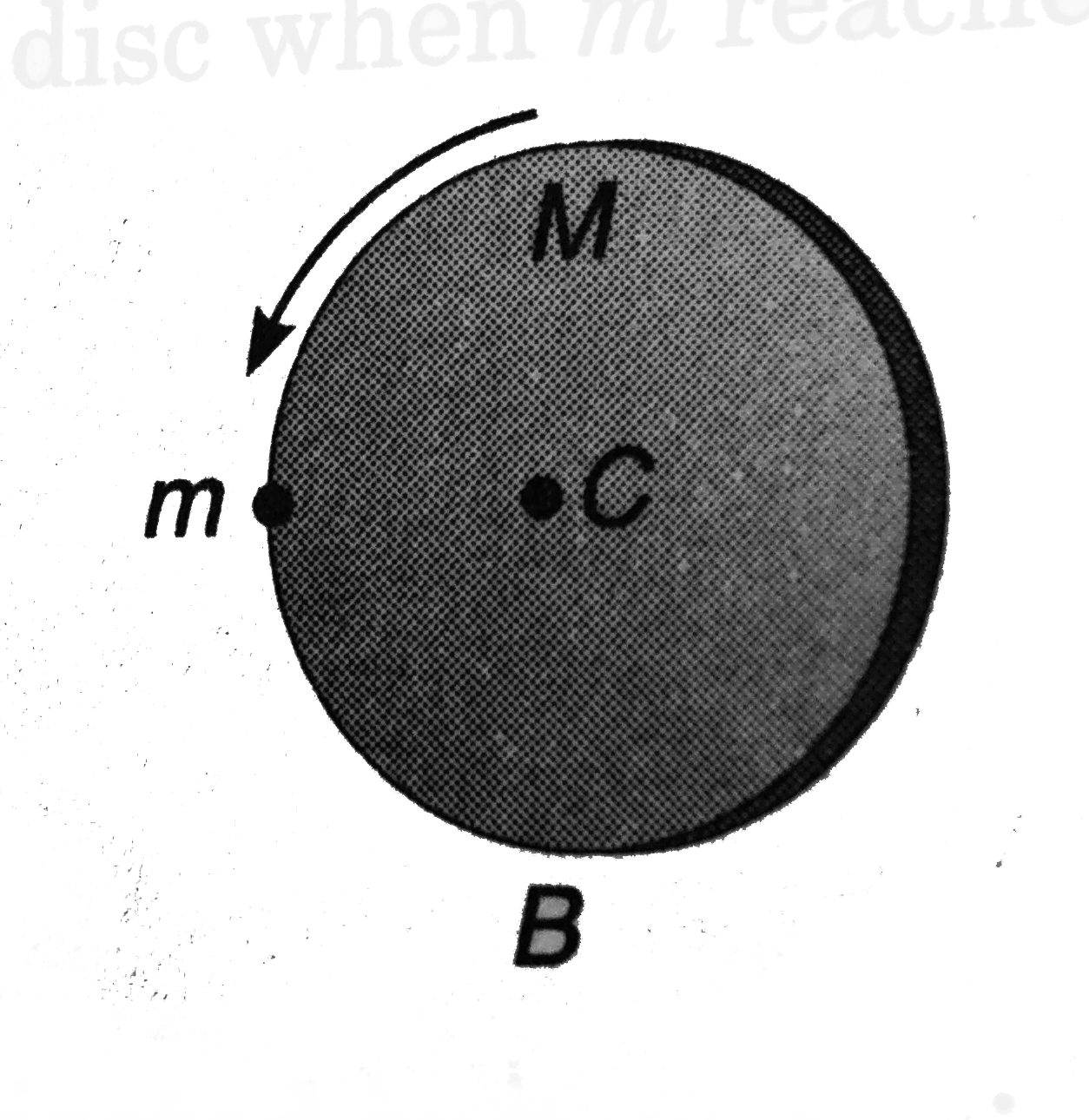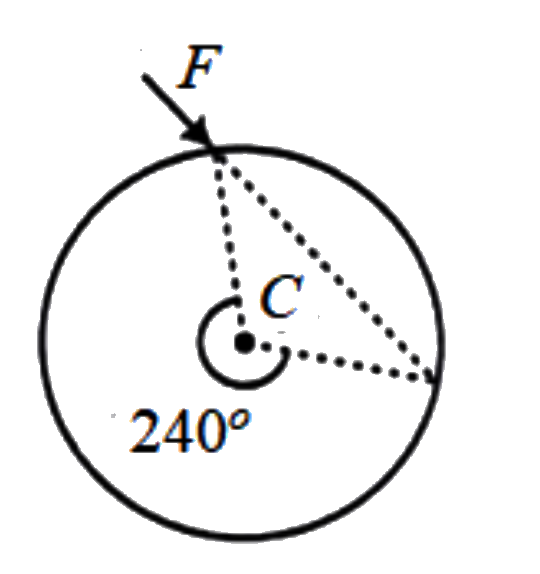A uniform disc of mass 20 kg and radius 0.5 m can turn about a smooth axis through its centre and perpendicular to the disc. A constant torque is applied to the disc for 3s from rest and the angular velocity at the ned of that time is 240πrev/min find the magnitude of the torque. if the torque is then removed and the disc is brought to rest in t seconds by a constant force of 10 N applied tangentially at a point on the rim of the disc, find t
To solve the problem step by step, we will first find the torque applied to the disc and then calculate the time t it takes to bring the disc to rest after the torque is removed.
Step 1: Convert Angular Velocity to Radians per Second
The angular velocity given is 240π revolutions per minute (rev/min). We need to convert this to radians per second (rad/s).
ω=240π rev/min×2π rad1 rev×1 min60 s=240×2π60π=8 rad/s
Step 2: Calculate the Moment of Inertia of the Disc
The moment of inertia I of a uniform disc about its center is given by the formula:
I=12mr2
Where:
- m=20 kg (mass of the disc)
- r=0.5 m (radius of the disc)
Calculating I:
I=12×20×(0.5)2=12×20×0.25=2.5 kg m2
Step 3: Calculate the Torque
Using the relationship between torque, moment of inertia, and angular acceleration, we know:
τ=Iα
Where α (angular acceleration) can be calculated using the formula:
α=ΔωΔt
Given that the disc starts from rest (Δω=ω−0=8 rad/s) and the time interval Δt=3 s:
α=83 rad/s2
Now substituting I and α into the torque equation:
τ=2.5×83=203 N m
Step 4: Calculate the Time t to Bring the Disc to Rest
When the torque is removed, a tangential force F=10 N is applied at the rim of the disc to bring it to rest. The torque due to this force is:
τ=F⋅r
Substituting the values:
τ=10⋅0.5=5 N m
Now, we can use the relationship between torque, moment of inertia, and angular deceleration β:
τ=Iβ⟹β=τI=52.5=2 rad/s2
Since the disc is coming to rest, the angular deceleration is β=−2 rad/s2.
Using the kinematic equation for angular motion:
ωf=ωi+βt
Where:
- ωf=0 rad/s (final angular velocity)
- ωi=8 rad/s (initial angular velocity)
Substituting the values:
0=8−2t⟹2t=8⟹t=4 s
Final Answers
- The magnitude of the torque is 203 N m.
- The time t to bring the disc to rest is 4 s.
The angular velocity given is 240π revolutions per minute (rev/min). We need to convert this to radians per second (rad/s).
The moment of inertia I of a uniform disc about its center is given by the formula:
- m=20 kg (mass of the disc)
- r=0.5 m (radius of the disc)
Using the relationship between torque, moment of inertia, and angular acceleration, we know:
When the torque is removed, a tangential force F=10 N is applied at the rim of the disc to bring it to rest. The torque due to this force is:
- ωf=0 rad/s (final angular velocity)
- ωi=8 rad/s (initial angular velocity)
- The magnitude of the torque is 203 N m.
- The time t to bring the disc to rest is 4 s.
Topper's Solved these Questions
- ROTATIONAL MECHANICSBook:DC PANDEY ENGLISHChapter:ROTATIONAL MECHANICSExercise:Level 2 Single Correct
Explore 26 Videos
- ROTATIONAL MECHANICSBook:DC PANDEY ENGLISHChapter:ROTATIONAL MECHANICSExercise:Level 2 Multiple Correct
Explore 36 Videos
- ROTATIONAL MECHANICSBook:DC PANDEY ENGLISHChapter:ROTATIONAL MECHANICSExercise:Level 1 Objective
Explore 30 Videos
- ROTATIONBook:DC PANDEY ENGLISHChapter:ROTATIONExercise:(C) Chapter Exercises
Explore 39 Videos
- ROTATIONAL MOTIONBook:DC PANDEY ENGLISHChapter:ROTATIONAL MOTIONExercise:Integer Type Questions
Explore 17 Videos
Similar Questions

A uniform disc of mass M and radius R is pivoted about the horizontal axis through its centre C A point mass m is glued to the disc at its rim, as shown in figure. If the system is released from rest, find the angular velocity of the disc when m reaches the bottom point B.
View SolutionMoment of inertia of a uniform quarter disc of radius R and mass M about an axis through its centre of mass and perpendicular to its plane is :
View SolutionMoment of inertia of a uniform quarter disc of radius R and mass M about an axis through its centre of mass and perpendicular to its plane is :
View SolutionA circular disc has a mass of 1kg and radius 40 cm. It is rotating about an axis passing through its centre and perpendicular to its plane with a speed of 10rev/s. The work done in joules in stopping it would be-
View SolutionRadius of gyration of a uniform circular disc about an axis passing through its centre of gravity and perpendicular to its plane is
View SolutionA uniform disc of mass M and radius R is hinged at its centre C . A force F is applied on the disc as shown . At this instant , angular acceleration of the disc is

View SolutionA circular copper disc 100cm in radius rotates at 20πrad/s about an axis through its centre and perpendicular to the disc. A uniform magnetic field of 0.2T acts perpendicular to the disc. Calculate the potential difference developed between the axis of the disc and the rim
View SolutionA disc of radius r is removed from the centre of a disc of mass M and radius R. The M.I. About the axis through the centre and normal to the plane will be:
View SolutionThe radius of gyration of a uniform disc about a line perpendicular to the disc equals to its radius. Find the distance of the line from the centre.
View SolutionIf a circular concentric hole is made on a disc then about an axis passing through the centre of the disc and perpendicular to its plane
View Solution